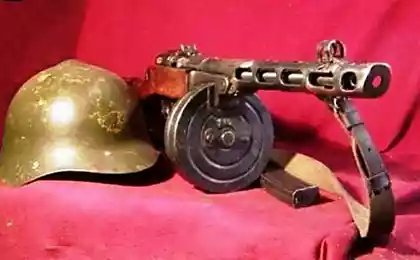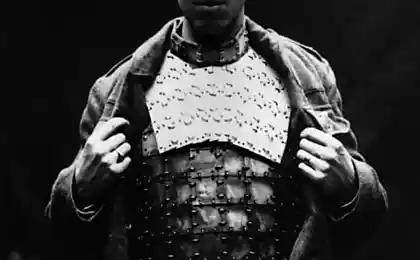2049
Unusual ammunition of World War I (58 photos)
Not that it's not spur progress (unfortunately) the war. Smart leader seeks not only to defeat the enemy, but also to protect their soldiers. And the soldiers are in no hurry to die trying to protect yourself.
Inventions made at the front of the good life - do not have time or forgot rear inventors and designers to invent this or that useful thing before the war, we have to pitch in by soldiers. So before the first world were quite simple but effective device.
French trench armor against bullets and shrapnel. 1915.
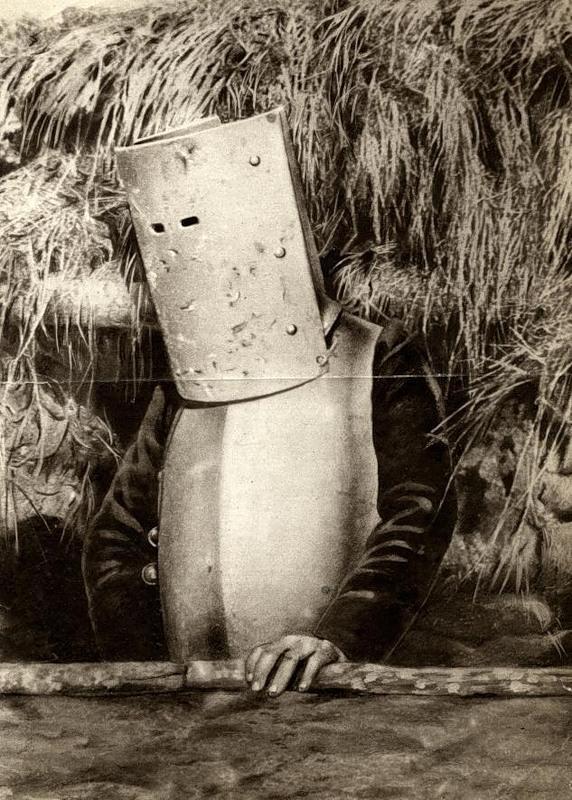
Sappenpanzer appeared on the Western Front in 1916. In June 1917, capturing several German bullet-proof vests, the Allies conducted a study. According to these documents, the German body armor can stop a bullet rifle at a distance of 500 meters, but its main purpose against shrapnel and debris. The vest can be hung on the back as well on the chest. The first samples collected were less severe than later, with an initial thickness of 2 to 3 mm. The material - silicon alloy steel and nickel.
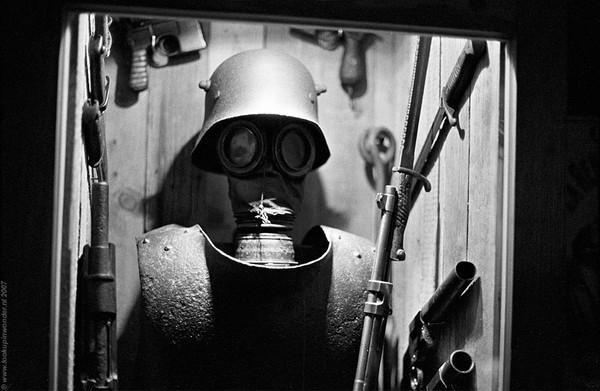


Such here masochku were the commander and the driver for the British Mark I face protection from splinters.

Barricade.
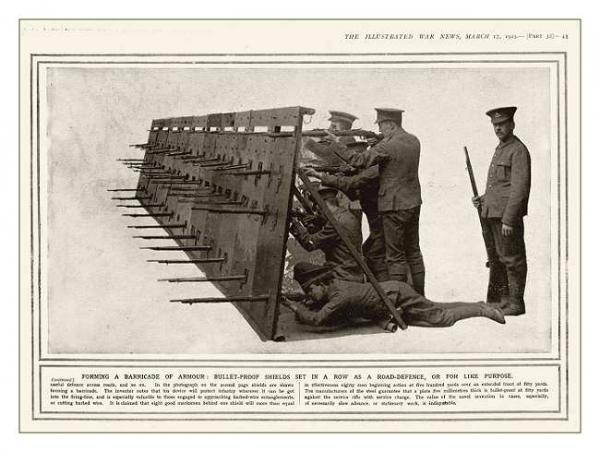
German soldiers captured trying on a Russian "mobile barricade».

Mobile infantry shield (France).
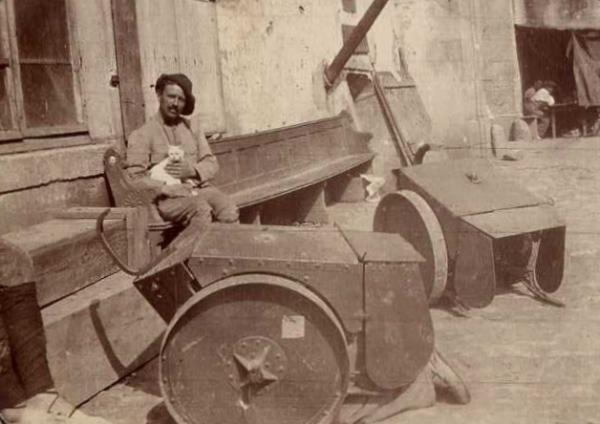
Pilot helmets gunners. USA, 1918.

USA. Protection for bomber pilots. Bronetrusy.

Different versions of armored shields for police officers from Detroit.

Austrian trench shield that could be worn as a bib.

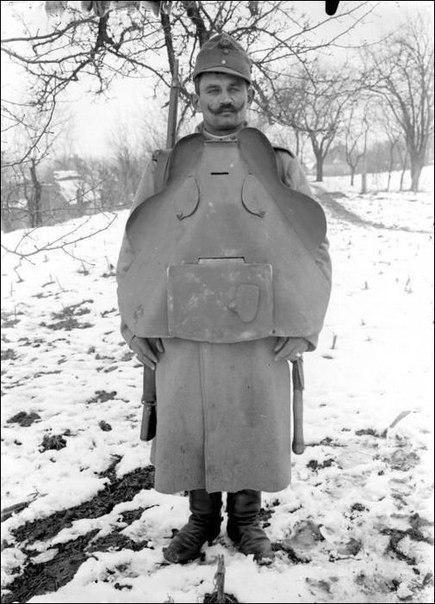
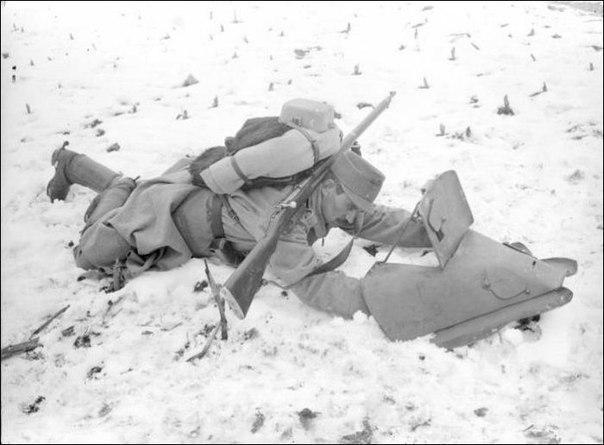

"Ninja Turtles" from Japan.


Broneschit for caregivers.


Body armor with uncomplicated name "Turtle". I understand that "sex" This thing was not a fighter, and he moved it.

Shovel Shield MacAdam, Canada, 1916. It was supposed dual use: both as blades, and small shield. It was commissioned by the Canadian government a series of 22 000 units. As a result, the device was uncomfortable as a shovel uncomfortable because of too low position loopholes as small shield, and made its way through rifle bullets. After the war, melted down as scrap

I could not pass up such a wonderful stroller (though already the post-war). UK 1938

And finally, "the armored cabin of a public toilet - pepelats." Armored observation post. UK.

Not only sit behind the backboard. Adversary "vykovyrnut" due to shield what? And then, "necessity is the mother (the soldiers) the mother of invention ... In the course went absolutely exotic means.
French Bomb-throwing machine. Medieval technology once again in demand.


Well ... sovseeem slingshot!

But they need to somehow move. Here again entered the system engineering genius and production capacity.
Urgent and rather stupid conversion of any self-propelled mechanism gave rise to sometimes amazing creatures.

April 24, 1916 in Dublin broke out anti-government uprising (Easter Rising - Easter Rising) for the movement of troops on the streets of the British bombard needed at least some armored vehicles.
April 26, just 10 hours experts backup 3rd Cavalry Regiment, workshop equipment using the Southern Railway in Inchicore, were able to collect the armored car from normal commercial 3-ton cargo gear "Daimler" and ... a steam boiler. Both the chassis and boiler have been delivered to the brewery "Guinness"

About armor-hand car, you can write a separate article, because only limited to one photograph to the overall presentation.

A trivial example is hanging steel shields on the side of the truck for military purposes.
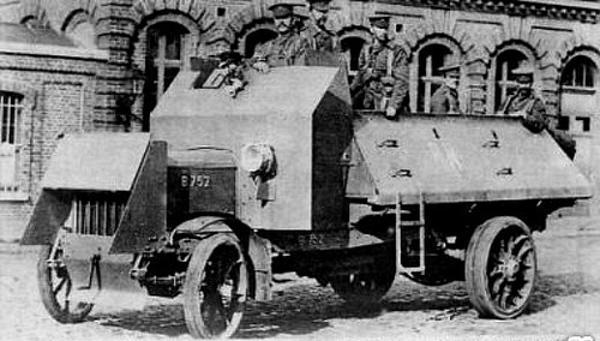
Danish "armored car" made by Gideon Truck 2 T 1917 with armor made of plywood (!).

Another French hack (in this case the service of Belgium) - armored Peugeot. Again, without the protection of the driver, motor, and even the rest of the crew in the front.
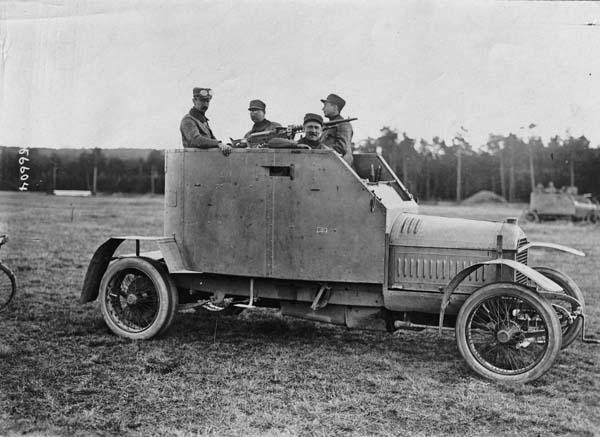

And how do you like that kind of "aerotachanka" from 1915?

Or this ...
1915 Sizaire-Berwick "Wind Wagon". Death to the enemy (for diarrhea), the infantry will blow.
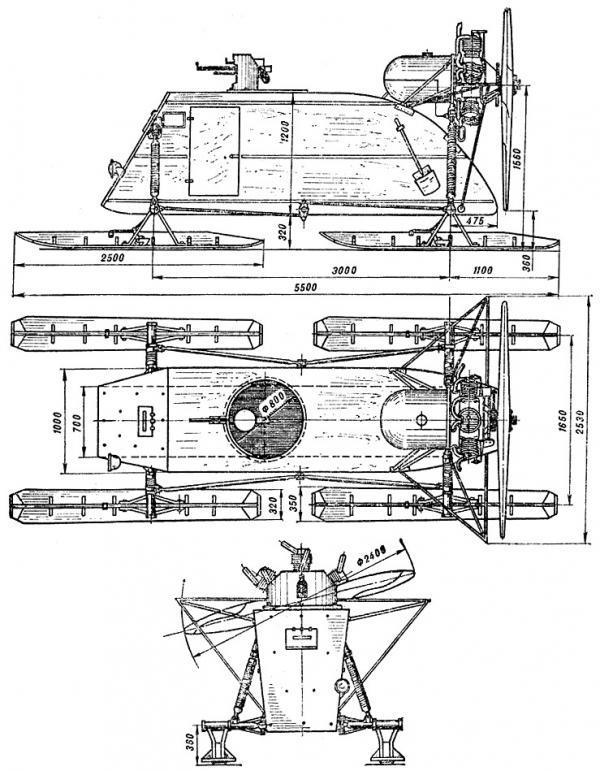
Later, after WW1 idea aero-carts are not stalled, and was developed and in demand (especially in the snowy expanses of the north of the USSR).
Snowmobiling were made of wood frameless gated enclosure, the front of which was protected by a sheet of bulletproof armor. In front of the housing is the Department of Management, which is a driver. To monitor the road in front of the inspection there was a gap with the glass blocks from the BA-20. For the Department of Management was fighting compartment, which was mounted on the turret 7, 62-mm tank gun DT, equipped with a light shield cover. The fire from a machine gun led the commander of snowmobiles. Horizontal angle of fire was 300 °, vertical - from -14 to 40 °. Ammunition gun was 1,000 cartridges.
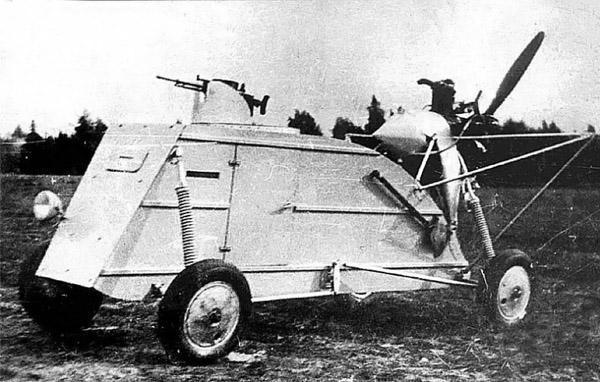
By August 1915 two officers of the Austro-Hungarian army - Hauptmann engineer Romanik and Oberleutnant Fellner, Budapest constructed here is a glamorous armored car, presumably on the basis of a Mercedes car with 95 horsepower engine. He was named the first letters of the names of the creators Romfell. Reservations for 6 mm. Armed with a gun was Schwarzlose M07 / December 8 mm (3000 rounds ammunition) in the turret, buyout could in principle be used against air targets. The car was equipped with radio telegraph Morse code, from the firm of Siemens & Halske. The speed of the machine up to 26 km / h. Weight 3 tons, length of 5, 67 m, width 1, 8 m, height of 2, 48 m. The crew of 2 persons.

And this monster so pleased Mironov, do not deny yourself the pleasure again to show it. In June 1915 began production tractor factory Marienwagen Daimler in Berlin-Marienfelde. This truck is available in several versions: a semi-tracked, fully tracked, although the base was a 4-ton truck Daimler.

To break through the fields, barbed wire invented just such senoprovolokokosilku.


June 30, 1915 another of the prototype was assembled in the courtyard of a London prison "Wormwood Scrubs" soldiers of the 20th Squadron of the Royal Navy School of Aviation. The basis was taken undercarriage American tractor "Kill Stright" wooden Tracians Track.

In July it on a trial basis established by armored hull of "Delano-Belleville", then - the case of the "Austin" and the tower of "Lanchester".

Tank FROT-TURMEL-LAFFLY, wheeled tank, built on the chassis of road roller Laffly. Protected 7 mm book, weighs about 4 tons, armed with two 8-mm machine guns and mitrailleuse unknown type and caliber. By the way, the photograph is much stronger arms Statement - apparently "holes for guns" to cut through the reserve.
The exotic shape of the body due to the fact that the idea of the designer (the same city are put on), the machine was intended for attacks on the barbed wire, the machine that was supposed to press down his body - in fact monstrous barbed wire, along with machine guns, were one of the main problems for the infantry.

The French have a brilliant idea - to use to overcome the enemy barbed wire small-caliber gun, firing grappling hooks. In the photo the calculations of guns.
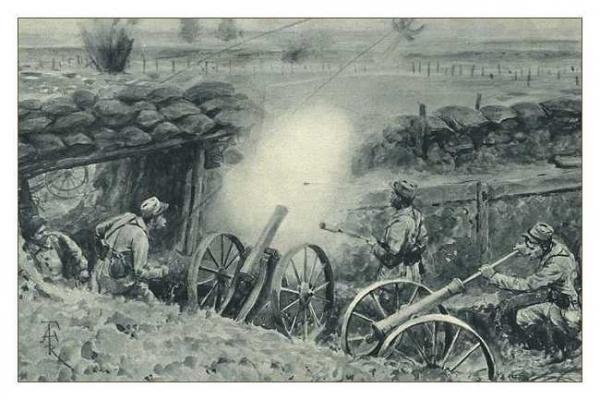
Well, so as not only humiliated motorcycles, trying to adapt them to the military action ...
Mototachanka trailer Motosacoche.

Another.

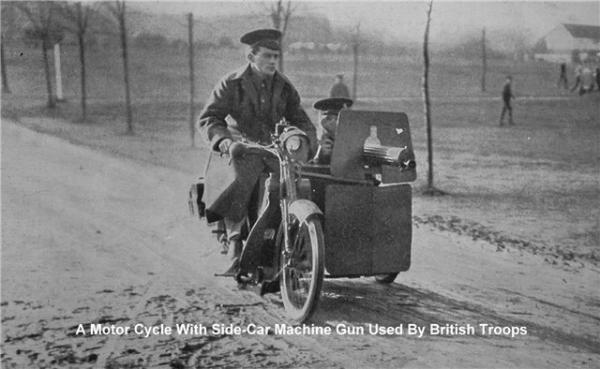

Contact.
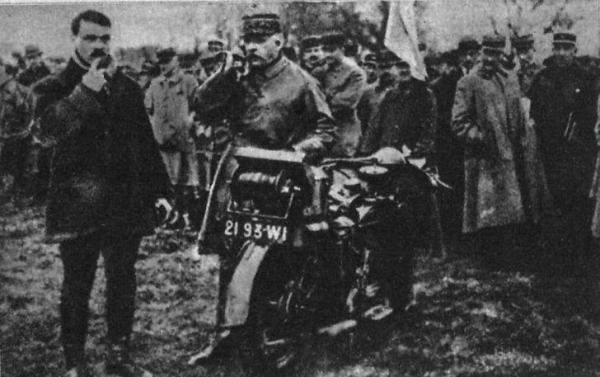
Field Ambulance.

Delivery of fuel.

Three-wheeled armored motorcycle, intended for solving intelligence tasks, especially for narrow roads.

Interesting that - only "Grillo tracked the boat!" Just to drive the alligators on the marshy banks of the Adriatic, postrelivaya torpedoes ... In fact, participating in subversive operations, was shot while trying to sink a battleship "Viribus Unitis". Due to the silent electric motor at night and made his way to the port, using caterpillars moved through protecting booms. But seen in the port security and flooded.

Displacement was of 10 tons, armament - four 450mm torpedo.
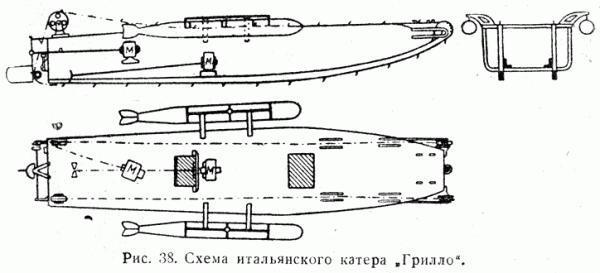
But to overcome water obstacles individually developed other means. Such for example as:
Martial waterskiing.
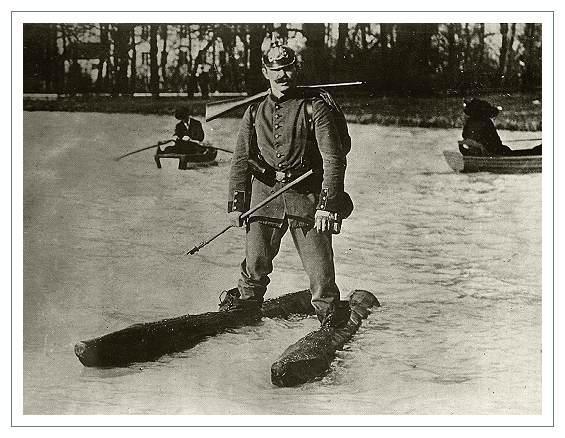
Battle catamaran.

Martial stilts

But this is R2D2. Self-propelled firing point on electricity. Behind her through the entire field of battle dragged "tail" -cable.
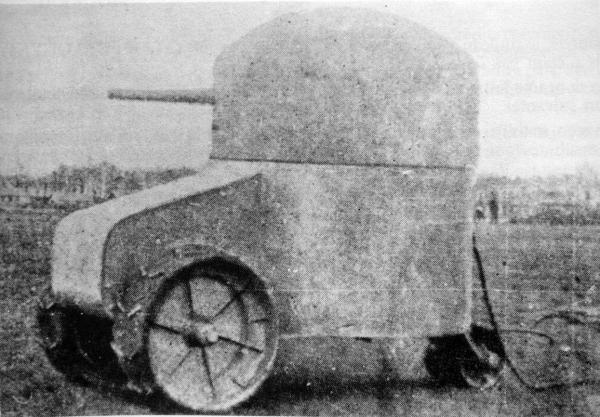
Inventions made at the front of the good life - do not have time or forgot rear inventors and designers to invent this or that useful thing before the war, we have to pitch in by soldiers. So before the first world were quite simple but effective device.
French trench armor against bullets and shrapnel. 1915.

Sappenpanzer appeared on the Western Front in 1916. In June 1917, capturing several German bullet-proof vests, the Allies conducted a study. According to these documents, the German body armor can stop a bullet rifle at a distance of 500 meters, but its main purpose against shrapnel and debris. The vest can be hung on the back as well on the chest. The first samples collected were less severe than later, with an initial thickness of 2 to 3 mm. The material - silicon alloy steel and nickel.



Such here masochku were the commander and the driver for the British Mark I face protection from splinters.

Barricade.

German soldiers captured trying on a Russian "mobile barricade».

Mobile infantry shield (France).

Pilot helmets gunners. USA, 1918.

USA. Protection for bomber pilots. Bronetrusy.

Different versions of armored shields for police officers from Detroit.

Austrian trench shield that could be worn as a bib.




"Ninja Turtles" from Japan.


Broneschit for caregivers.


Body armor with uncomplicated name "Turtle". I understand that "sex" This thing was not a fighter, and he moved it.

Shovel Shield MacAdam, Canada, 1916. It was supposed dual use: both as blades, and small shield. It was commissioned by the Canadian government a series of 22 000 units. As a result, the device was uncomfortable as a shovel uncomfortable because of too low position loopholes as small shield, and made its way through rifle bullets. After the war, melted down as scrap

I could not pass up such a wonderful stroller (though already the post-war). UK 1938

And finally, "the armored cabin of a public toilet - pepelats." Armored observation post. UK.

Not only sit behind the backboard. Adversary "vykovyrnut" due to shield what? And then, "necessity is the mother (the soldiers) the mother of invention ... In the course went absolutely exotic means.
French Bomb-throwing machine. Medieval technology once again in demand.


Well ... sovseeem slingshot!

But they need to somehow move. Here again entered the system engineering genius and production capacity.
Urgent and rather stupid conversion of any self-propelled mechanism gave rise to sometimes amazing creatures.

April 24, 1916 in Dublin broke out anti-government uprising (Easter Rising - Easter Rising) for the movement of troops on the streets of the British bombard needed at least some armored vehicles.
April 26, just 10 hours experts backup 3rd Cavalry Regiment, workshop equipment using the Southern Railway in Inchicore, were able to collect the armored car from normal commercial 3-ton cargo gear "Daimler" and ... a steam boiler. Both the chassis and boiler have been delivered to the brewery "Guinness"

About armor-hand car, you can write a separate article, because only limited to one photograph to the overall presentation.

A trivial example is hanging steel shields on the side of the truck for military purposes.

Danish "armored car" made by Gideon Truck 2 T 1917 with armor made of plywood (!).

Another French hack (in this case the service of Belgium) - armored Peugeot. Again, without the protection of the driver, motor, and even the rest of the crew in the front.


And how do you like that kind of "aerotachanka" from 1915?

Or this ...
1915 Sizaire-Berwick "Wind Wagon". Death to the enemy (for diarrhea), the infantry will blow.

Later, after WW1 idea aero-carts are not stalled, and was developed and in demand (especially in the snowy expanses of the north of the USSR).
Snowmobiling were made of wood frameless gated enclosure, the front of which was protected by a sheet of bulletproof armor. In front of the housing is the Department of Management, which is a driver. To monitor the road in front of the inspection there was a gap with the glass blocks from the BA-20. For the Department of Management was fighting compartment, which was mounted on the turret 7, 62-mm tank gun DT, equipped with a light shield cover. The fire from a machine gun led the commander of snowmobiles. Horizontal angle of fire was 300 °, vertical - from -14 to 40 °. Ammunition gun was 1,000 cartridges.

By August 1915 two officers of the Austro-Hungarian army - Hauptmann engineer Romanik and Oberleutnant Fellner, Budapest constructed here is a glamorous armored car, presumably on the basis of a Mercedes car with 95 horsepower engine. He was named the first letters of the names of the creators Romfell. Reservations for 6 mm. Armed with a gun was Schwarzlose M07 / December 8 mm (3000 rounds ammunition) in the turret, buyout could in principle be used against air targets. The car was equipped with radio telegraph Morse code, from the firm of Siemens & Halske. The speed of the machine up to 26 km / h. Weight 3 tons, length of 5, 67 m, width 1, 8 m, height of 2, 48 m. The crew of 2 persons.

And this monster so pleased Mironov, do not deny yourself the pleasure again to show it. In June 1915 began production tractor factory Marienwagen Daimler in Berlin-Marienfelde. This truck is available in several versions: a semi-tracked, fully tracked, although the base was a 4-ton truck Daimler.

To break through the fields, barbed wire invented just such senoprovolokokosilku.


June 30, 1915 another of the prototype was assembled in the courtyard of a London prison "Wormwood Scrubs" soldiers of the 20th Squadron of the Royal Navy School of Aviation. The basis was taken undercarriage American tractor "Kill Stright" wooden Tracians Track.

In July it on a trial basis established by armored hull of "Delano-Belleville", then - the case of the "Austin" and the tower of "Lanchester".

Tank FROT-TURMEL-LAFFLY, wheeled tank, built on the chassis of road roller Laffly. Protected 7 mm book, weighs about 4 tons, armed with two 8-mm machine guns and mitrailleuse unknown type and caliber. By the way, the photograph is much stronger arms Statement - apparently "holes for guns" to cut through the reserve.
The exotic shape of the body due to the fact that the idea of the designer (the same city are put on), the machine was intended for attacks on the barbed wire, the machine that was supposed to press down his body - in fact monstrous barbed wire, along with machine guns, were one of the main problems for the infantry.

The French have a brilliant idea - to use to overcome the enemy barbed wire small-caliber gun, firing grappling hooks. In the photo the calculations of guns.

Well, so as not only humiliated motorcycles, trying to adapt them to the military action ...
Mototachanka trailer Motosacoche.

Another.



Contact.

Field Ambulance.

Delivery of fuel.

Three-wheeled armored motorcycle, intended for solving intelligence tasks, especially for narrow roads.

Interesting that - only "Grillo tracked the boat!" Just to drive the alligators on the marshy banks of the Adriatic, postrelivaya torpedoes ... In fact, participating in subversive operations, was shot while trying to sink a battleship "Viribus Unitis". Due to the silent electric motor at night and made his way to the port, using caterpillars moved through protecting booms. But seen in the port security and flooded.

Displacement was of 10 tons, armament - four 450mm torpedo.

But to overcome water obstacles individually developed other means. Such for example as:
Martial waterskiing.

Battle catamaran.

Martial stilts

But this is R2D2. Self-propelled firing point on electricity. Behind her through the entire field of battle dragged "tail" -cable.












